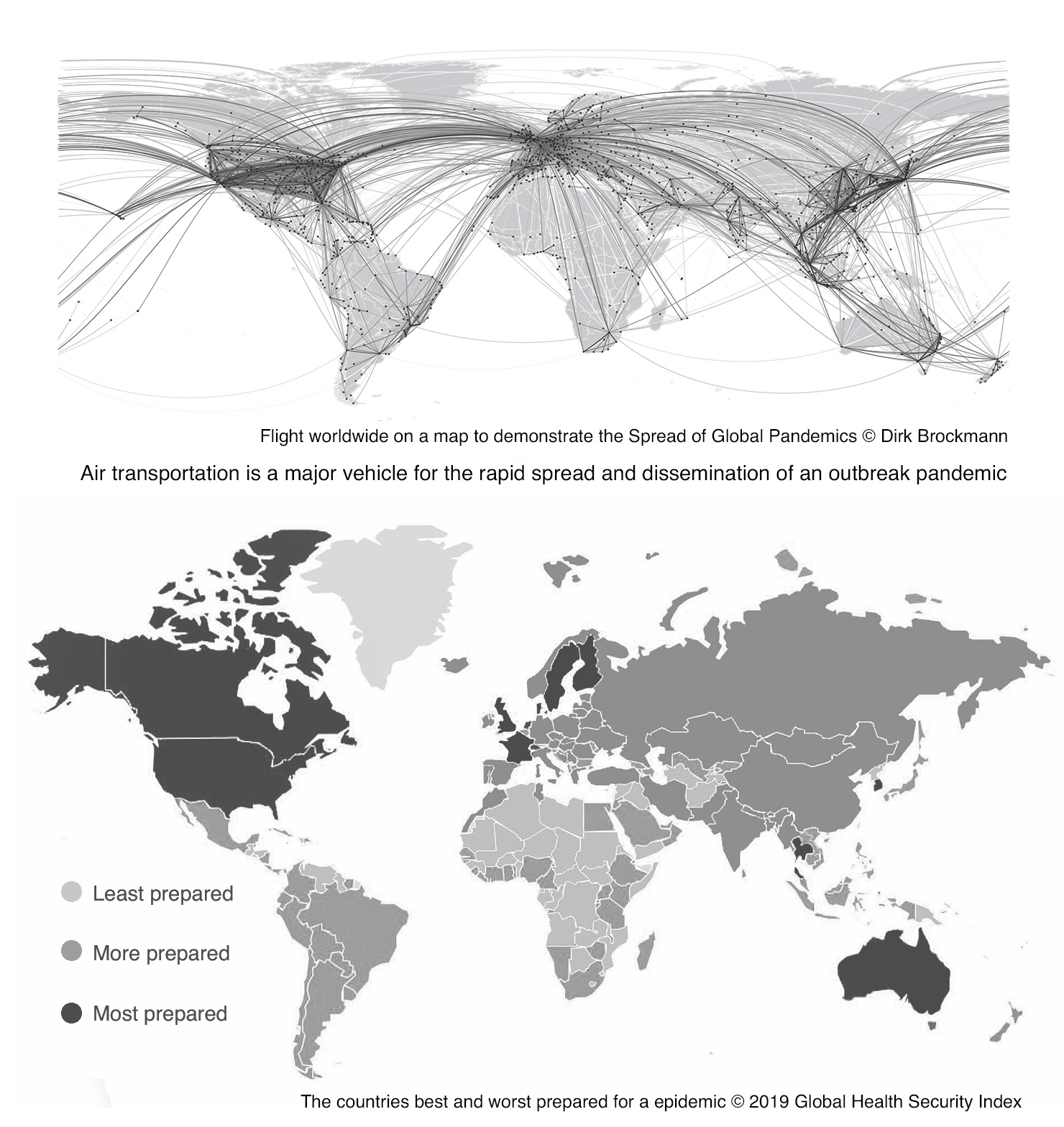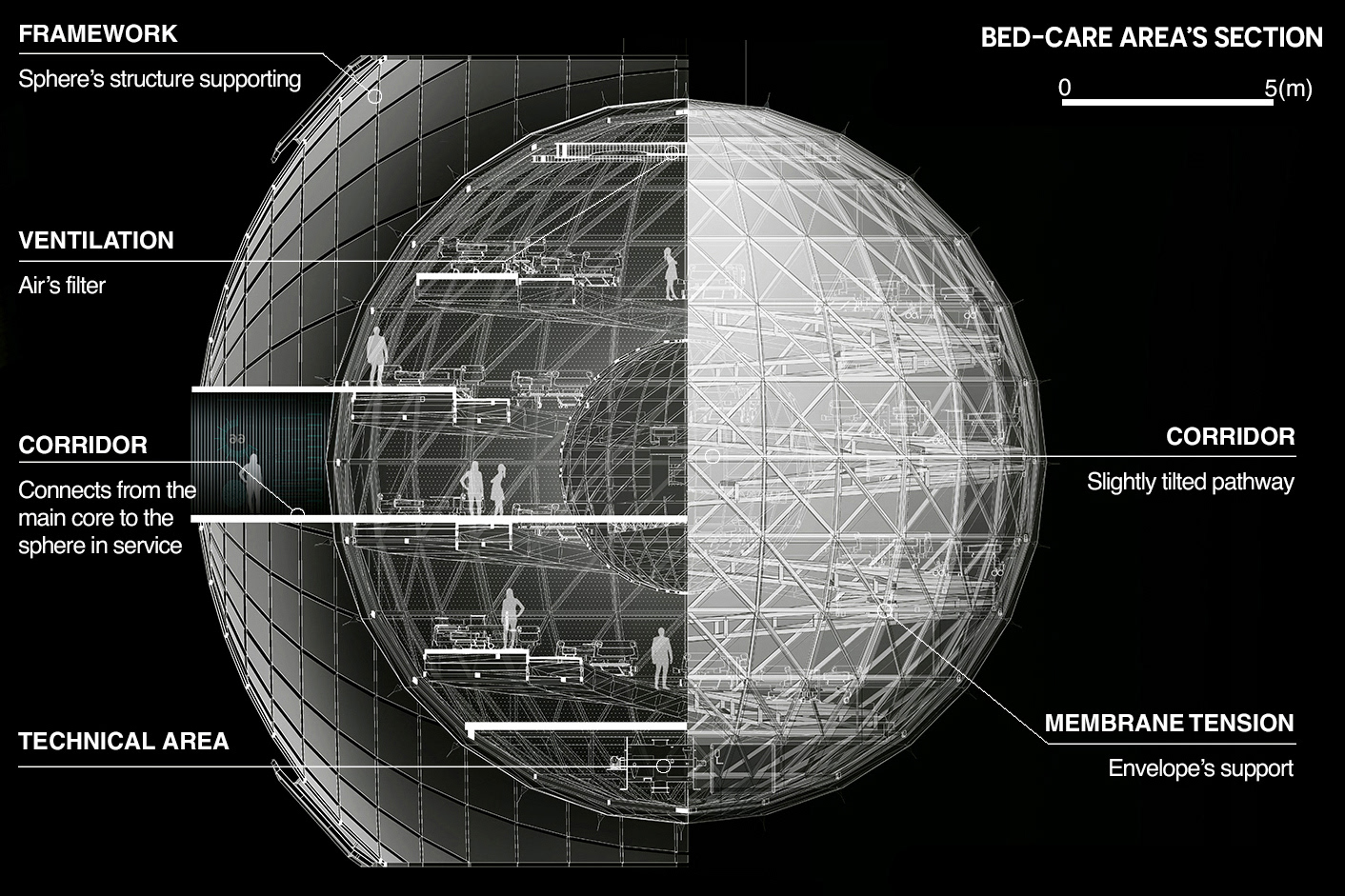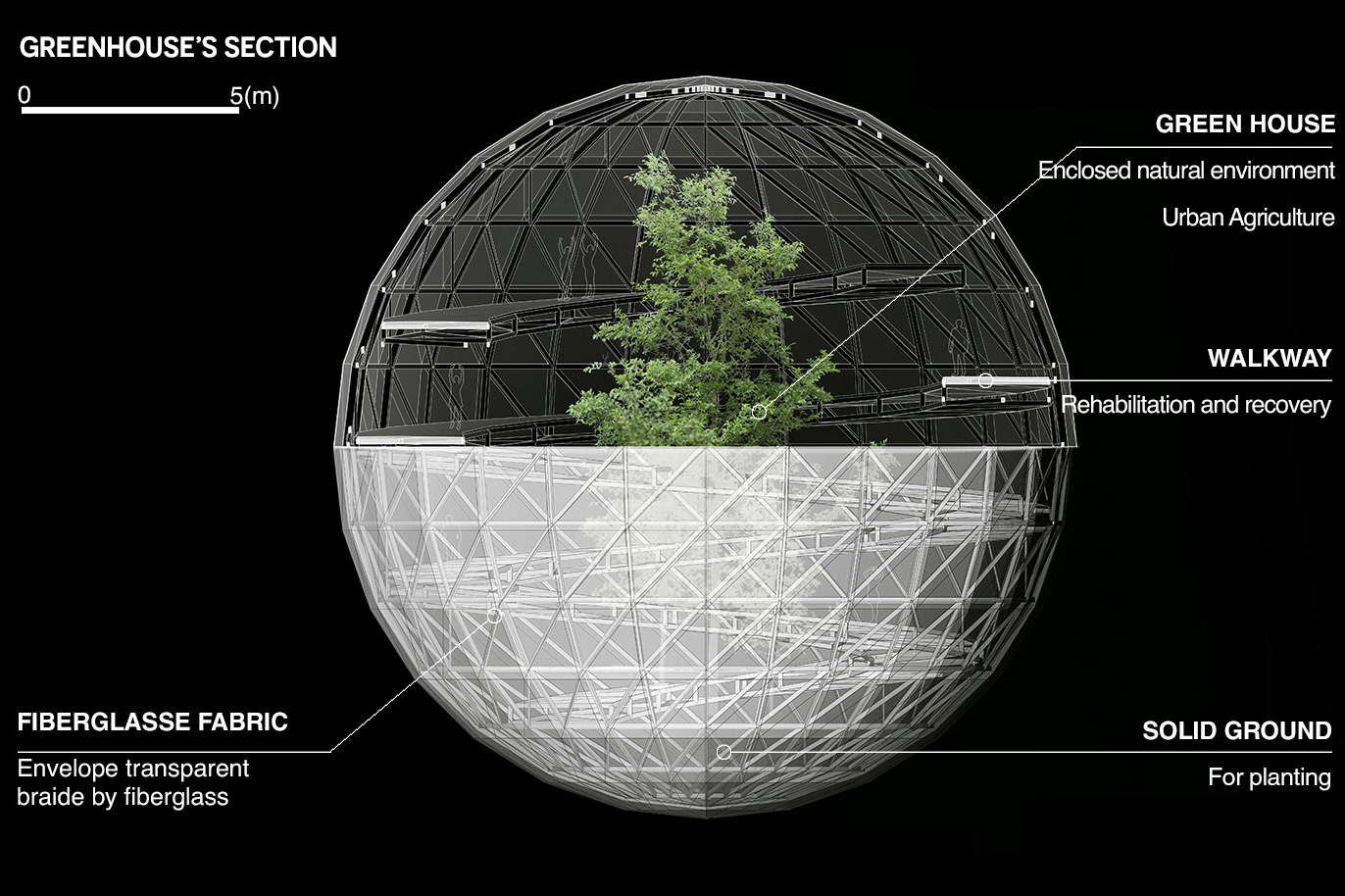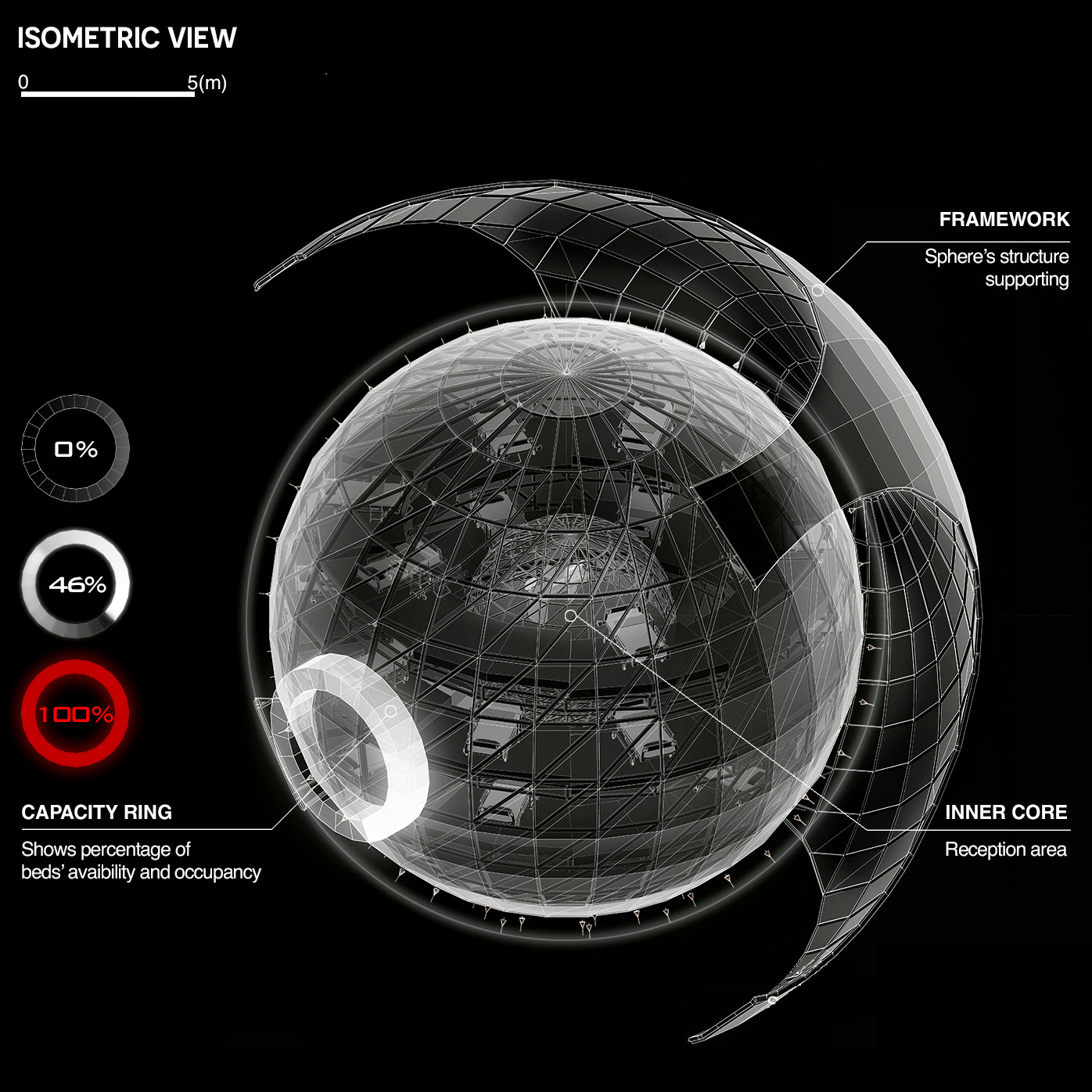2020 eVolo Magazine skycraper design competition
RANKING / 5/473 projects / HONORABLE MENTION
DAO Duy Tung x NGO Thanh Ha Tien
According to the report of Swedish Global Challenges Foundation in collaboration with the University of Oxford's Future of Humanity Institute, there’s a 5 percent chance that in the next 100 years, humans will be wiped out by a global pandemic or a nuclear war. A century ago, a strain of pandemic flu killed up to 100 million people—5 percent of the world’s population. In 2013, a new mystery illness swept the western coast of North America, causing starfish to disintegrate. In 2015, a big-nosed Asian antelope known as the saiga lost two-thirds of its population—some 200,000 individuals—to what now looks to be a bacterial infection. Faced the risk of Biological warfare (BW)—also known as germ warfare—which is the use of biological toxins or infectious agents such as bacteria, viruses, and fungi with the intent to kill or incapacitate humans, animals or plants as an act of war; and the evolution of unidentified influenza, are we human beings on our way to meet the end of the world?
Every second decade since the 18th century, humankind had to deal with a deadly pandemic. Started with the year 1972, we were having The Great Plague of Marseille in France, in 1820 the Cholera pandemic, and then 1920s the Spanish flu. In early 2020, a virus with the name Corona, the "Wuhan virus" referred to these days, is a new virus of the corona strain (dubbed 2019-nCoV or nCoV), which has never been detected before.
On 31 January 2019, the World Health Organisation declared the outbreak of a novel coronavirus a global health emergency, an acknowledgment of the risk the virus poses to countries beyond its origin in China and of the need for a more coordinated international response to the outbreak. The fatality rate in Wuhan is 4.1 percent and there is currently still no vaccine to prevent 2019-nCoV infection. At this infection rate, Chinese government ordered to build a 60,000-square-metre structure with space for 1,000 beds and 30 intensive care wards.
On behalf of a global citizen and an architect, we were thinking of a system of pandemic emergency supply station, whose target is to brave a situation like this of a virus’ outbreak. Its main function will be urgent care service in order to fill in the inadequate hospital resources with a program of diagnosis room, intensive therapy, treatment room, bed-care area with medical equipment… Especially, to meet the emergency requirement, the building has to use modularization technology in order to be assembled in a very short time. vertically configured buildings facilitate more efficient infrastructure in case metropole, where occurs primarily most case of a pandemic outbreak. This emergency supply station is capable of adapting to many terrains, especially in areas with poorly prepared for an epidemic, such as Africa, Asia, South America…
Viruses are a public enemy of human beings, and to take a win in the battle against the novel coronavirus as early as possible is a goal shared by the world. The novel coronavirus outbreak is drawing concerns from the world. In the face of the epidemic, human beings share the same destiny, and only unity and collaboration are able to generate the power to safeguard lives. At this moment, what the world needs is not hypes made by the busybodies, the prejudices and discrimination from the narrow-minded, or the irresponsible labeling and distorting by certain western media. Unity and goodwill shall be the mainstream. And after each pandemic, a lesson is learned: It’s “not yet time to let down our guard".
-
Selon le rapport de la Fondation des défis mondiaux suédoise en collaboration avec l'Institut pour le futur de l'humanité de l'Université d'Oxford, il y a une probabilité de 5% qu'au cours des 100 prochaines années, les humains soient anéantis par une pandémie mondiale ou une guerre nucléaire. Il y a un siècle, une souche de grippe pandémique a tué jusqu'à 100 millions de personnes, soit 5% de la population mondiale. En 2013, une nouvelle maladie mystérieuse a balayé la côte ouest de l'Amérique du Nord, causant la désintégration des étoiles de mer. En 2015, une antilope asiatique au nez proéminent connue sous le nom de saïga a perdu les deux tiers de sa population - environ 200 000 individus - à ce qui semble maintenant être une infection bactérienne. Face au risque de la guerre biologique (BW) - également connue sous le nom de guerre germique - qui consiste à utiliser des toxines biologiques ou des agents infectieux tels que des bactéries, des virus et des champignons dans le but de tuer ou d'incapaciter les humains, les animaux ou les plantes en temps de guerre; et à l'évolution de la grippe non identifiée, sommes-nous en train de nous diriger vers la fin du monde?
Tous les deuxième décennies depuis le XVIIIe siècle, l'humanité a dû faire face à une pandémie mortelle. Tout a commencé en 1720 avec la Grande Peste de Marseille en France, suivie en 1820 par la pandémie de choléra, puis dans les années 1920 par la grippe espagnole. Début 2020, un virus appelé Corona, également connu sous le nom de "virus de Wuhan", est un nouveau virus de la souche corona (surnommé 2019-nCoV ou nCoV), qui n'avait jamais été détecté auparavant.
Le 31 janvier 2019, l'Organisation mondiale de la santé a déclaré l'épidémie d'un nouveau coronavirus une urgence de santé mondiale, reconnaissant ainsi le risque que le virus pose aux pays au-delà de son origine en Chine et la nécessité d'une réponse internationale plus coordonnée à l'épidémie. Le taux de mortalité à Wuhan est de 4,1 % et il n'y a actuellement aucun vaccin pour prévenir l'infection par le 2019-nCoV. Avec ce taux d'infection, le gouvernement chinois a ordonné la construction d'une structure de 60 000 mètres carrés pouvant accueillir 1 000 lits et 30 unités de soins intensifs.
Au nom d'un citoyen mondial et d'un architecte, nous avons réfléchi à un système de station d'approvisionnement d'urgence en cas de pandémie, dont l'objectif est de faire face à une situation comme celle d'une épidémie virale. Sa fonction principale sera de fournir des services de soins urgents afin de combler les lacunes des ressources hospitalières insuffisantes, avec un programme comprenant une salle de diagnostic, une thérapie intensive, une salle de traitement, une zone de soins de lit avec du matériel médical... Surtout, pour répondre aux exigences d'urgence, le bâtiment doit utiliser la technologie de modularisation afin d'être assemblé en très peu de temps. Les bâtiments configurés verticalement facilitent une infrastructure plus efficace en cas de métropole, où se produisent principalement la plupart des cas d'épidémies. Cette station d'approvisionnement d'urgence est capable de s'adapter à de nombreux terrains, en particulier dans les zones mal préparées pour une épidémie, telles que l'Afrique, l'Asie, l'Amérique du Sud...
Les virus sont un ennemi public des êtres humains, et gagner la bataille contre le nouveau coronavirus le plus tôt possible est un objectif partagé par le monde. L'épidémie de nouveau coronavirus suscite des préoccupations dans le monde entier. Face à l'épidémie, les êtres humains partagent le même destin et seule l'unité et la collaboration peuvent générer le pouvoir de sauvegarder des vies. En ce moment, ce dont le monde a besoin n'est pas de l'hype créée par les curieux, les préjugés et la discrimination des étroits d'esprit ou l'étiquetage et la distorsion irresponsables de certains médias occidentaux. L'unité et la bonne volonté doivent être la norme. Et après chaque pandémie, une leçon est apprise : ce n'est pas encore le moment de baisser la garde".
Deadliest Pandemics of History
Corona Virus become one of the most deadliest pandemics in History with 1.4M deaths counted (December 2020)


Pandemic World Map
The recent pandemic caused by COVID‐19 has globally affected air transport mobility as well as the airline industry in general. In this list of the countries best and worst prepared for an Epidemic in 2019, the countries that are medically well prepared now are the biggest Corona outbreaks globally (USA, Europe)
The recent pandemic caused by COVID‐19 has globally affected air transport mobility as well as the airline industry in general. In this list of the countries best and worst prepared for an Epidemic in 2019, the countries that are medically well prepared now are the biggest Corona outbreaks globally (USA, Europe)
Installation and Dismantling
The process of installing and disassembling of the Pandemic Emergency Supply Station (PESS)





PESS’ Section
The drawing indicates circulation, ventilation and the relationship between spaces on one skyscraper.
Bed-care area’s Plan
Arrangement’s plan in one room unit
Bed-care area’s Section
The beds are arranged on a slope, the number of beds can be up to 24 beds per room unit
Green house’s section
Natural spaces have been implanted in a sphere's unit that serves as a therapeutic place.
Isometric view
Correlation between sphere’s unit and installation’s location. Each sphere is equipped with a light reporting system for the bed-care area’s availability.
The drawing indicates circulation, ventilation and the relationship between spaces on one skyscraper.
Bed-care area’s Plan
Arrangement’s plan in one room unit
Bed-care area’s Section
The beds are arranged on a slope, the number of beds can be up to 24 beds per room unit
Green house’s section
Natural spaces have been implanted in a sphere's unit that serves as a therapeutic place.
Isometric view
Correlation between sphere’s unit and installation’s location. Each sphere is equipped with a light reporting system for the bed-care area’s availability.
Collage perspective simulates the PESS’ installation around the world (in China, France, USA…)
The perspective of an installed PESS on the outskirts of the city. Diagram of exploded isometric describes the relationship of the core, structure and other elements (skin, diagnostic zone,…)
